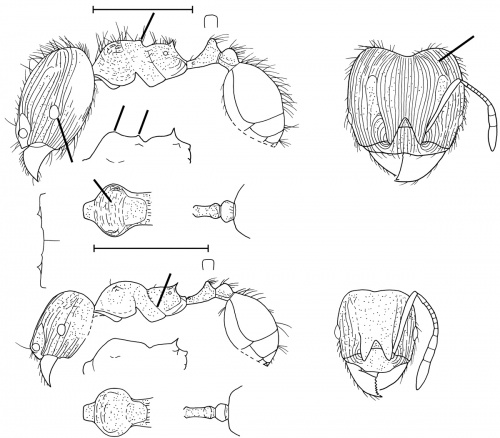Pheidole striaticeps
| Pheidole striaticeps | |
|---|---|

| |
| Scientific classification | |
| Kingdom: | Animalia |
| Phylum: | Arthropoda |
| Class: | Insecta |
| Order: | Hymenoptera |
| Family: | Formicidae |
| Subfamily: | Myrmicinae |
| Tribe: | Attini |
| Genus: | Pheidole |
| Species: | P. striaticeps |
| Binomial name | |
| Pheidole striaticeps Mayr, 1870 | |
| Synonyms | |
| |
Pheidole striaticeps is a widespread, moderately abundant species (Longino, 2019). Longino (1997) reports it from mature rainforest, nesting under the bark of rotting stumps and logs. At Cuzco Amazónico, near Puerto Maldonado, Stefan Cover and John E. Tobin found a colony in a gap within mature rainforest, beneath the bark of a rotten but still hard log. (Wilson 2003)
Identification
See the description in the nomenclature section.
Keys including this Species
Distribution
Mexico (almost certainly tropical Mexico), Honduras, Costa Rica, and Amazonian Peru and the Atlantic slope to 500 m and Pacific lowlands of Costa Rica. (Wilson 2003)
Latitudinal Distribution Pattern
Latitudinal Range: 18.0601° to -2.687467°.
| North Temperate |
North Subtropical |
Tropical | South Subtropical |
South Temperate |
- Source: AntMaps
Distribution based on Regional Taxon Lists
Neotropical Region: Costa Rica (type locality), Guatemala, Honduras, Mexico (type locality).
Oriental Region: India.
Distribution based on AntMaps
Distribution based on AntWeb specimens
Check data from AntWeb
Countries Occupied
| Number of countries occupied by this species based on AntWiki Regional Taxon Lists. In general, fewer countries occupied indicates a narrower range, while more countries indicates a more widespread species. |

|
Estimated Abundance
| Relative abundance based on number of AntMaps records per species (this species within the purple bar). Fewer records (to the left) indicates a less abundant/encountered species while more records (to the right) indicates more abundant/encountered species. |

|
Biology
Castes
Worker
Minor
Images from AntWeb
   
| |
| Syntype Pheidole chloe. Worker. Specimen code jtlc000014075. Photographer John T. Longino, uploaded by California Academy of Sciences. | Owned by MHNG. |
  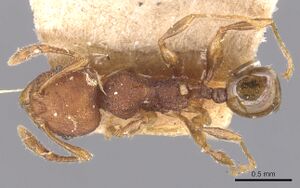 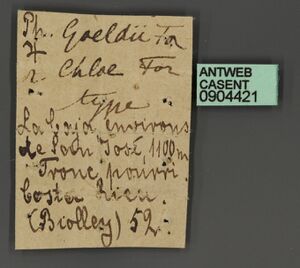
| |
| Syntype of Pheidole goeldii chloe. Worker. Specimen code casent0904421. Photographer Will Ericson, uploaded by California Academy of Sciences. | Owned by MSNG, Genoa, Italy. |
Major
Images from AntWeb
 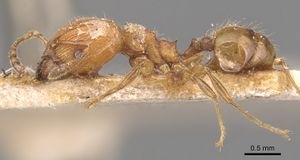  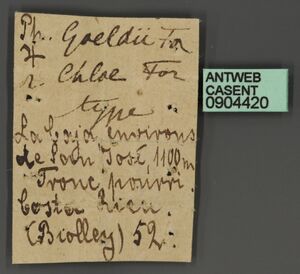
| |
| Syntype of Pheidole goeldii chloe. Worker (major/soldier). Specimen code casent0904420. Photographer Will Ericson, uploaded by California Academy of Sciences. | Owned by MSNG, Genoa, Italy. |
Nomenclature
The following information is derived from Barry Bolton's Online Catalogue of the Ants of the World.
- striaticeps. Pheidole striaticeps Mayr, 1870b: 987 (s.w.) MEXICO.
- Status as species: Wilson, 2003: 512.
- Senior synonym of chloe: Longino, 2019: 60.
- chloe. Pheidole goeldii subsp. chloe Forel, 1908b: 56 (s.w.) COSTA RICA.
- Status as species: Wilson, 2003: 399.
- Junior synonym of striaticeps: Longino, 2019: 60.
Unless otherwise noted the text for the remainder of this section is reported from the publication that includes the original description.
Taxonomic Notes
Longino (2019) - AntWeb images of the type and associated paralectotypes of both P. striaticeps and P. chloe clearly reveal their conspecificity.
Description
From Wilson (2003): DIAGNOSIS A member of the flavens group close to Pheidole cardiella, Pheidole goeldii, Pheidole mittermeieri, Pheidole nuculiceps and Pheidole sculptior, distinguished as follows.
Major: antennal scrobes present; entire dorsal surface of head covered by longitudinal carinulae, which curve inwardly toward midline at occiput; humerus prominent and rounded in dorsal-oblique view; mesonotal convexity present, especially in dorsal-oblique view; head wider than long (Head Width/Head Length 1.03); pronotum transversely carinulate.
Minor: carinulae absent from around thorax-propodeal suture.
MEASUREMENTS (mm) Lectotype major: HW 1.06, HL 1.02, SL 0.56, EL 0.12, PW 0.50. Paralectotype minor: HW 0.62, HL 0.62, SL 0.56, EL 0.08, PW 0.42.
COLOR Major: concolorous light reddish brown.
Minor: concolorous light reddish brown.
Pheidole striaticeps
From Wilson (2003): A member of the flavens group close to Pheidole striaticeps of Mexico and Central America (and a possible synonym of it), much less so to the other species listed in the heading, and distinguished as follows.
Major: antennal scrobes present; entire dorsal surface of head, except for frontal triangle, covered by longitudinal carinulae, which do not curve inwardly toward midline at occiput; humerus subangulate in dorsal-oblique view; mesonotal convexity absent in both side and dorsal-oblique views; head wider than long (HW/HL 1.04); pronotum lacks transverse carinulae.
Minor: longitudinal carinulae stretch from mesopleuron to sides of propodeum.
MEASUREMENTS (mm) Syntype major: HW 1.00, HL 0.96, SL 0.56, EL 0.14, PW 0.50.
Syntype minor: PW 0.36 (head missing in syntype available).
COLOR Major: concolorous light reddish brown.
Minor: body brownish yellow (color of head unknown).
Pheidole striaticeps. Upper: lectotype, major. Lower: paralectotype, minor. Scale bars = 1 mm.
Pheidole striaticeps. Upper: syntype, major. Lower: syntype, minor. Scale bars = 1 mm.
Type Material
Pheidole striaticeps; MEXICO. Naturhistorisches Museum Wien, Vienna - as reported in Wilson (2003)
Pheidole striaticeps: COSTA RICA: La Caja, vicinity of San José, 1100 m, col. Paul Biolley. Musee d'Histoire Naturelle Genève and Museum of Comparative Zoology - as reported in Wilson (2003)
Etymology
Pheidole striaticeps: L striaticeps, lined (striate) head. (Wilson 2003)
Pheidole striaticeps: Gr chloe, first green shoots of plants in spring, allusion unknown. (Wilson 2003)
References
- Wilson, E. O. 2003. Pheidole in the New World: A dominant, hyperdiverse ant genus. Harvard University Press, Cambridge, MA. (page 512, fig. major, minor described)
- Bracko, G., Wagner, H.C., Schulz, A., Gioahin, E., Maticic, J., Trantnik, A. 2014. New investigation and a revised checklist of the ants (Hymenoptera: Formicidae) of the Republic of Macedonia. North-Western Journal of Zoology 10: 10-24.
- Longino, J.T. 2019. Pheidole (Hymenoptera, Formicidae) of Middle American Wet Forest. Zootaxa 4599: 1–126 (DOI 10.11646/zootaxa.4599.1.1).
- Mayr, G. 1870b. Neue Formiciden. Verh. K-K. Zool.-Bot. Ges. Wien 20: 939-996 (page 987, soldier, worker described)
References based on Global Ant Biodiversity Informatics
- Bezdeckova K., P. Bedecka, and I. Machar. 2015. A checklist of the ants (Hymenoptera: Formicidae) of Peru. Zootaxa 4020 (1): 101–133.
- Dattilo W. et al. 2019. MEXICO ANTS: incidence and abundance along the Nearctic-Neotropical interface. Ecology https://doi.org/10.1002/ecy.2944
- Donoso D. A. 2014. Assembly mechanisms shaping tropical litter ant communities. Ecography 37 doi: 10.1111/j.1600-0587.2013.00253.x
- Fernández, F. and S. Sendoya. 2004. Lista de las hormigas neotropicales. Biota Colombiana Volume 5, Number 1.
- Forel A. 1908. Fourmis de Costa-Rica récoltées par M. Paul Biolley. Bulletin de la Société Vaudoise des Sciences Naturelles 44: 35-72.
- Kempf, W.W. 1972. Catalago abreviado das formigas da regiao Neotropical (Hym. Formicidae) Studia Entomologica 15(1-4).
- Longino J. T. 2013. Ants of Nicargua. Consulted on 18 Jan 2013. https://sites.google.com/site/longinollama/reports/ants-of-nicaragua
- Longino J. T. 2019. Pheidole (Hymenoptera, Formicidae) of Middle American wet forest. Zootaxa 4599: 1-126
- Longino J. T. L., and M. G. Branstetter. 2018. The truncated bell: an enigmatic but pervasive elevational diversity pattern in Middle American ants. Ecography 41: 1-12.
- Longino J. T., J. Coddington, and R. K. Colwell. 2002. The ant fauna of a tropical rain forest: estimating species richness three different ways. Ecology 83: 689-702.
- Longino J. et al. ADMAC project. Accessed on March 24th 2017 at https://sites.google.com/site/admacsite/


